Effects of Wildfire Smoke on Volatile Organic Compound (VOC) and PM2.5 Composition in a United States Intermountain Western Valley and Estimation of Human Health Risk
Abstract
1. Introduction
2. Materials and Methods
2.1. Volatile Organic Compound (VOC) Data
2.2. PM2.5 Data
2.3. Health Risk Calculations
3. Results/Discussion
3.1. Observed Smoke Events and PM2.5 Trends
3.2. Concentrations of VOCs and PM2.5 in Wildfire Smoke in LCV
3.3. Passive-Sampling Comparison between Cities
3.4. Health Risk Assessment
3.5. Comparison with Previous Works
3.6. Limitations
4. Conclusions
- Wildfire smoke events lasted up to 30 days and PM2.5 daily exposures spiked up to 200 µg/m3.
- Several VOCs were elevated in 2017–2018 smoke events, including air toxics (means in µg/m3): benzene (1.78), toluene (2.25), ethylbenzene (0.32), xylenes (1.02), phenol (0.66), and p-cymene (0.87).
- The lifetime hazard index of the LCV smoke exposures was below one, and considered low risk for non-cancer health events.
- There was an associated risk of 6–7 extra cancers per million in the LCV and Boise, Coeur d’Alene and Spokane, due to lifetime benzene exposure from smoke.
- Combined with other pollutants in the background air, the total cancer health risk of VOCs measured in the LCV was up to 13 extra cancers per million, which was consistent with an earlier study of the region [29].
- PM2.5 have increased in the LCV by 0.10 µg/m3/yr over the past 23 years, showing the impact of wildfires on the region.
Author Contributions
Funding
Institutional Review Board Statement
Informed Consent Statement
Data Availability Statement
Acknowledgments
Conflicts of Interest
References
- Hanan, E.J.; Ren, J.; Tague, C.L.; Kolden, C.A.; Abatzoglou, J.T.; Bart, R.R.; Kennedy, M.C.; Liu, M.; Adam, J.C. How climate change and fire exclusion drive wildfire regimes at actionable scales. Environ. Res. Lett. 2021, 16, 024051. [Google Scholar] [CrossRef]
- Spracklen, D.V.; Mickley, L.J.; Logan, J.A.; Hudman, R.C.; Yevich, R.; Flannigan, M.D.; Westerling, A.L. Impacts of climate change from 2000 to 2050 on wildfire activity and carbonaceous aerosol concentrations in the Western United States. J. Geophys. Res. 2009, 114, 1–17. [Google Scholar] [CrossRef]
- Steel, Z.L.; Safford, H.D.; Viers, J.H. The fire frequency-severity relationship and the legacy of fire suppression in California forests. Ecosphere 2015, 6, 8. [Google Scholar] [CrossRef]
- Williams, A.P.; Abatzoglou, J.T.; Gershunov, A.; Guzman-Morales, J.; Bishop, D.A.; Balch, J.K.; Lettenmaier, D.P. Observed Impacts of Anthropogenic Climate Change on Wildfire in California. Earth’s Future 2019, 7, 892–910. [Google Scholar] [CrossRef]
- Dennison, P.E.; Brewer, S.C.; Arnold, J.D.; Moritz, M.A. Large wildfire trends in the western United States, 1984–2011. Geophys. Res. Let. 2014, 1, 2928–2933. [Google Scholar] [CrossRef]
- Weber, K.T.; Yadav, R. Spatiotemporal Trends in Wildfires across the Western United States (1950–2019). Remote Sens. 2020, 12, 2959. [Google Scholar] [CrossRef]
- McGinnis, S.; Kessenich, L.; Mearns, L.; Cullen, A.; Podschwit, H.; Bukovsky, M. Future regional increases in simultaneous large Western USA wildfires. Int. J. Wildland Fire 2023, 32, 1304–1314. [Google Scholar] [CrossRef]
- Holden, Z.A.; Swanson, A.; Luce, C.H.; Jolly, W.M.; Maneta, M.; Oyler, J.W.; Warren, D.A.; Parsons, R.; Affleck, D. Decreasing fire season precipitation increased recent western US forest wildfire activity. Proc. Natl. Acad. Sci. USA 2018, 115, E8349–E8357. [Google Scholar] [CrossRef] [PubMed]
- Abatzoglou, J.T.; Williams, A.P. Impact of anthropogenic climate change on wildfire across western US forests. Proc. Natl. Acad. Sci. USA 2016, 113, 11770–11775. [Google Scholar] [CrossRef]
- Akagi, S.K.; Yokelson, R.J.; Wiedinmyer, C.; Alvarado, M.J.; Reid, J.S.; Karl, T.; Crounse, J.D.; Wennberg, P.O. Emission factors for open and domestic biomass burning for use in atmospheric models. Atmos. Chem. Phys. 2011, 11, 4039–4072. [Google Scholar] [CrossRef]
- Jaffe, D.; Bertschi, I.; Jaeglé, L.; Novelli, P.; Reid, J.S.; Tanimoto, H.; Vingarzan, R.; Westphal, D.L. Long-range transport of Siberian biomass burning emissions and impact on surface ozone in western North America. Geophys. Res. Lett. 2004, 31, 6–9. [Google Scholar] [CrossRef]
- Friedli, H.R.; Atlas, E.; Stroud, V.R.; Giovanni, L.; Campos, T.; Radke, L.F. Volatile organic trace gases emitted from North American wildfires. Glob. Biogeochem. Cycles 2001, 15, 435–452. [Google Scholar] [CrossRef]
- O’Dell, K.; Hornbrook, R.S.; Permar, W.; Levin, E.J.T.; Garofalo, L.A.; Apel, E.C.; Blake, N.J.; Jarnot, A.; Pothier, M.A.; Farmer, D.K.; et al. Hazardous Air Pollutants in Fresh and Aged Western US Wildfire Smoke and Implications for Long-Term Exposure. Environ. Sci. Technol. 2020, 54, 11838–11847. [Google Scholar] [CrossRef]
- Urbanski, S.P.; Hao, W.M.; Baker, S. Chapter 4 Chemical Composition of Wildland Fire Emissions. Dev. Environ. Sci. 2008, 8, 79–107. [Google Scholar] [CrossRef]
- Liang, Y.; Weber, R.J.; Misztal, P.K.; Jen, C.N.; Goldstein, A.H. Aging of Volatile Organic Compounds in October 2017 Northern California Wildfire Plumes. Environ. Sci. Technol. 2022, 2022, 1557–1567. [Google Scholar] [CrossRef]
- Jin, L.; Permar, W.; Selimovic, V.; Ketcherside, D.; Yokelson, R.J.; Hornbrook, R.S.; Apel, E.C.; Ku, I.-T.; Collett, J.L., Jr.; Sullivan, A.P.; et al. Constraining emissions of volatile organic compounds from western US wildfires with WE-CAN and FIREX-AQ airborne observations. Atmos. Chem. Phys. 2023, 23, 5969–5991. [Google Scholar] [CrossRef]
- McClure, C.D.; Jaffe, D.A. US particulate matter air quality improves except in wildfire-prone areas. Proc. Natl. Acad. Sci. USA 2018, 115, 7901–7906. [Google Scholar] [CrossRef] [PubMed]
- Rana, S.V.S.; Verma, Y. Biochemical Toxicity of Benzene. J. Environ. Biol. 2005, 26, 157–168. Available online: http://www.ncbi.nlm.nih.gov/pubmed/16161967 (accessed on 1 May 2024).
- Smith, M.T. The mechanism of benzene-induced leukemia: A hypothesis and speculations on the causes of leukemia. Environ. Health Perspect. 1996, 104 (Suppl. S6), 1219–1225. [Google Scholar] [CrossRef]
- Lipner, E.M.; O’Dell, K.; Brey, S.J.; Ford, B.; Pierce, J.R.; Fischer, E.V.; Crooks, J.L. The Associations Between Clinical Respiratory Outcomes and Ambient Wildfire Smoke Exposure Among Pediatric Asthma Patients at National Jewish Health, 2012–2015. GeoHealth 2019, 3, 146–159. [Google Scholar] [CrossRef] [PubMed]
- Jin, W.; Su, S.; Wang, B.; Zhu, X.; Chen, Y.; Shen, G.; Liu, J.; Cheng, H.; Wang, X.; Wu, S.; et al. Properties and cellular effects of particulate matter from direct emissions and ambient sources. J. Environ. Sci. Health 2016, 51, 1075–1083. [Google Scholar] [CrossRef] [PubMed]
- Gharibvand, L.; Beeson, W.L.; Shavlik, D.; Knutsen, R.; Ghasmsary, S.S.; Knutsen, S.F. The association between ambient fine particulate matter and incident adenocarcinoma subtype of lung cancer. Environ. Health 2017, 16, 71. [Google Scholar] [CrossRef] [PubMed]
- Pope, C.A., III. Lung Cancer, Cardiopulmonary Mortality, and Long-term Exposure to Fine Particulate Air Pollution. JAMA 2002, 287, 1132. [Google Scholar] [CrossRef]
- Kloog, I.; Ridgway, B.; Koutrakis, P.; Coull, B.A.; Schwartz, J.D. Long-and Short-Term Exposure to PM 2.5 and Mortality: Using Novel Exposure Models. Epidemiology 2013, 24, 555–561. [Google Scholar] [CrossRef] [PubMed]
- Molnar, P.; Gustafson, P.; Johannesson, S.; Boman, J.; Barregard, L.; Sallsten, G. Domestic wood burning and PM trace elements: Personal exposures, indoor and outdoor levels. Atmos. Environ. 2005, 39, 2643–2653. [Google Scholar] [CrossRef]
- Miller, D.D.; Bajracharya, A.; Dickinson, G.N.; Durbin, T.A.; McGarry, J.K.P.; Moser, E.P.; Nuñez, L.A.; Pukkila, E.J.; Scott, P.S.; Sutton, P.J.; et al. Diffusive uptake rates for passive air sampling: Application to volatile organic compound exposure during FIREX-AQ campaign. Chemosphere 2022, 287, 131808. [Google Scholar] [CrossRef]
- Warneke, C.; Schwarz, J.P.; Dibb, J.; Kalashnikova, O.; Frost, G.; Al-Saad, J.; Brown, S.S.; Brewer, W.A.; Soja, A.; Seidel, F.C.; et al. Fire Influence on Regional to Global Environments and Air Quality (FIREX-AQ). J. Geophys. Res. Atmos. 2023, 128, 2169–2897. [Google Scholar] [CrossRef]
- U.S. EPA. Air Quality System. Available online: https://www.epa.gov/outdoor-air-quality-data (accessed on 31 October 2020).
- Scott, P.S.; Andrew, J.P.; Bundy, B.A.; Grimm, B.K.; Hamann, M.A.; Ketcherside, D.T.; Li, J.; Manangquil, M.Y.; Nuñez, L.A.; Pittman, D.L.; et al. Observations of volatile organic and sulfur compounds in ambient air and health risk assessment near a paper mill in rural Idaho, U.S.A. Atmos. Pollut. Res. 2020, 11, 1870–1881. [Google Scholar] [CrossRef] [PubMed]
- Li, R.; Jobson, B.T.; Wen, M.; Li, A.L.; Huangfu, Y.; Zhang, W.; Hardy, R.; O’Keeffe, P.; Simpson, J.; Fauci, M.; et al. Anthropogenic, biogenic, and photochemical influences on surface formaldehyde and its significant decadal (2006–2017) decrease in the Lewiston-Clarkston valley of the northwestern United States. Chemosphere 2024, 349, 140962. [Google Scholar] [CrossRef]
- Nez Perce Tribe. Characterization of Air Toxics Concentrations around a Kraft Pulp and Paper Mill Facility, Lewiston, Idaho; 2009. Available online: https://www.epa.gov/sites/default/files/2020-01/documents/nptatstudyfinalreport93009.pdf (accessed on 1 September 2024).
- U.S. EPA. Method 325A—Volatile Organic Compounds from Fugitive and Area Sources: Sampler Deployment and VOC Sample Collection; 2015. Available online: https://www.epa.gov/sites/production/files/2016-07/documents/m-325a.pdf (accessed on 30 May 2020).
- U.S. EPA. Compendium Method TO-17 Determination of Volatile Organic Compounds in Ambient Air Using Active Sampling Onto Sorbent Tubes; 1999. Available online: https://www.epa.gov/sites/default/files/2019-11/documents/to-17r.pdf (accessed on 30 May 2020).
- U.S. EPA. Method 325B—Volatile Organic Compounds from Fugitive and Area Sources: Sampler Preparation and Analysis; 2019. Available online: https://www.epa.gov/emc/method-325b-volatile-organic-compounds-fugitive-and-area-sources-sampler-preparation-and (accessed on 1 September 2024).
- Markes International. Application Note 001 Uptake Rates for Tube-Type Axial Diffusive Samplers; Markes International: Bridgend, UK, 2015. [Google Scholar]
- U.S. EPA. Criteria Air Pollutants; 2024. Available online: https://www.epa.gov/criteria-air-pollutants/naaqs-table (accessed on 3 May 2024).
- U.S. EPA. Risk Assessment Guidance for Superfund Volume I: Human Health Evaluation Manual (Part F, Supplemental Guidance for Inhalation Risk Assessment); Office of Superfund Remediation and Technology Innovation Environmental Protection Agency: Washington, DC, USA, 2009; pp. 1–68.
- U.S. EPA. OSWER Directive 9200.1-120; U.S. EPA: Washington, DC, USA, 2014.
- U.S. EPA. Integrated Risk Assessment System; 2024. Available online: https://www.epa.gov/iris (accessed on 1 October 2021).
- U.S. EPA. AirNow. Available online: https://gispub.epa.gov/airnow/index.html?tab=3 (accessed on 15 March 2019).
- Meinardi, S.; Simpson, I.J.; Blake, N.J.; Blake, D.R.; Rowland, F.S. Dimethyl disulfide (DMDS) and dimethyl sulfide (DMS) emissions from biomass burning in Australia. Geophys. Res. Lett. 2003, 30, 1454. [Google Scholar] [CrossRef]
- Gelencsér, A.; Siszler, K.; Hlavay, J. Toluene-benzene concentration ratio as a tool for characterizing the distance from vehicular emission sources. Environ. Sci. Technol. 1997, 31, 2869–2872. [Google Scholar] [CrossRef]
- Koss, A.R.; Sekimoto, K.; Gilman, J.B.; Selimovic, V.; Coggon, M.M.; Zarzana, K.J.; Yuan, B.; Lerner, B.M.; Brown, S.S.; Jimenez, J.L.; et al. Non-methane organic gas emissions from biomass burning: Identification, quantification, and emission factors from PTR-ToF during the FIREX 2016 laboratory experiment. Atmos. Chem. Phys. 2018, 18, 3299–3319. [Google Scholar] [CrossRef]
- Zhang, Z.; Zhang, Y.; Wang, X.; Lü, S.; Huang, Z.; Huang, X.; Yang, W.; Wang, Y.; Zhang, Q. Spatiotemporal patterns and source implications of aromatic hydrocarbons at six rural sites across China’s developed coastal regions. J. Geophys. Res. Atmos. 2016, 121, 6669–6687. [Google Scholar] [CrossRef]
- Dickinson, G.N.; Miller, D.D.; Bajracharya, A.; Bruchard, W.; Durbin, T.A.; McGarry, J.K.P.; Moser, E.P.; Nuñez, L.A.; Pukkila, E.P.; Scott, P.S.; et al. Health Risk Implications of Volatile Organic Compounds in Wildfire Smoke during the 2019 FIREX-AQ Campaign and Beyond. GeoHealth. 2022, 6, e2021GH000546. [Google Scholar] [CrossRef]
- McCarthy, M.C.; O’Brien, T.E.; Charrier, J.G.; Hafner, R.H. Characterization of the Chronic Risk and Hazard of Hazardous Air Pollutants in the United States Using Ambient Monitoring Data. Environ. Health Perspect. 2009, 117, 790–796. [Google Scholar] [CrossRef]
- Navarro, K.M.; West, M.R.; O’Dell, K.; Sen, P.; Chen, I.C.; Fischer, E.v.; Hornbrook, R.S.; Apel, E.C.; Hills, A.J.; Jarnot, A.; et al. Exposure to Particulate Matter and Estimation of Volatile Organic Compounds across Wildland Firefighter Job Tasks. Environ. Sci. Technol. 2021, 55, 11795–11804. [Google Scholar] [CrossRef]
- Wang, Z.M.; Wang, P.; Wagner, J.; Kumagai, K. Impacts on Urban VOCs and PM2.5 during a Wildfire Episode. Environments 2024, 11, 63. [Google Scholar] [CrossRef]
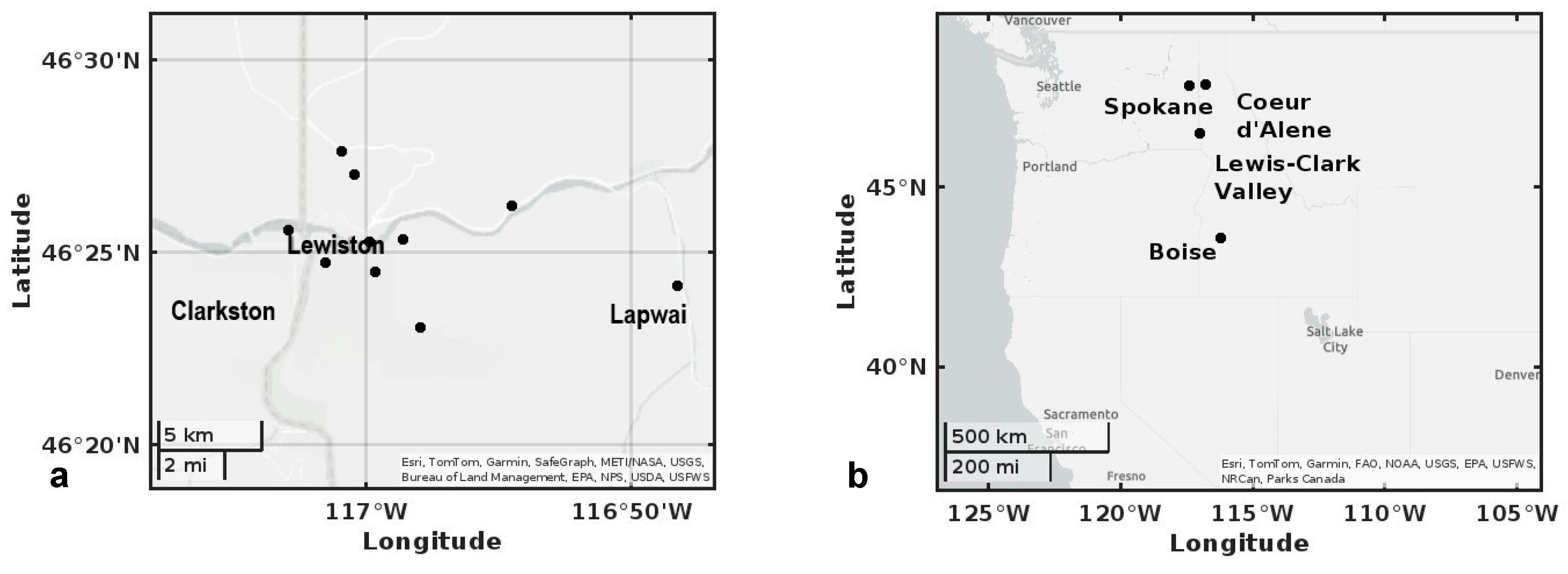
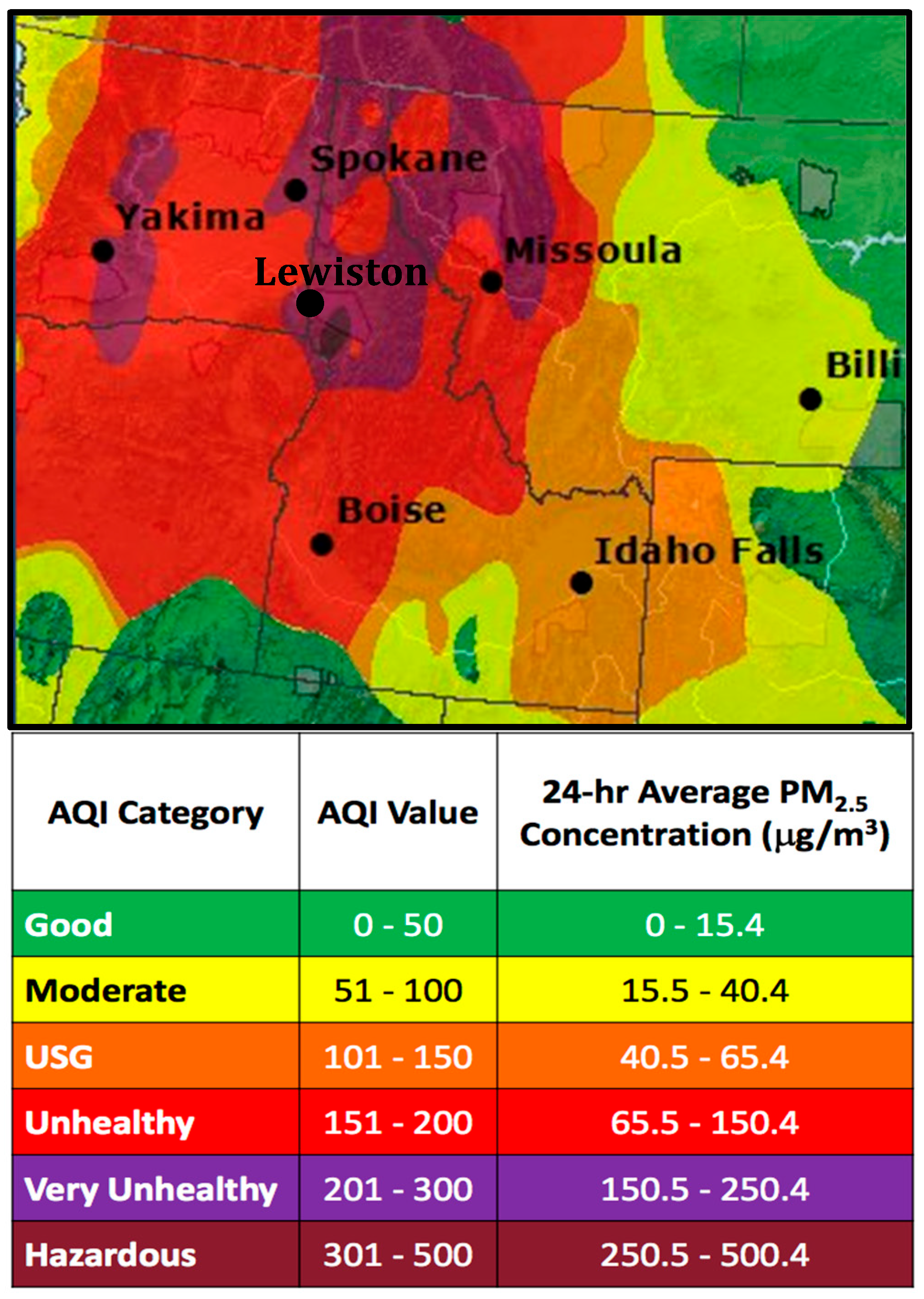

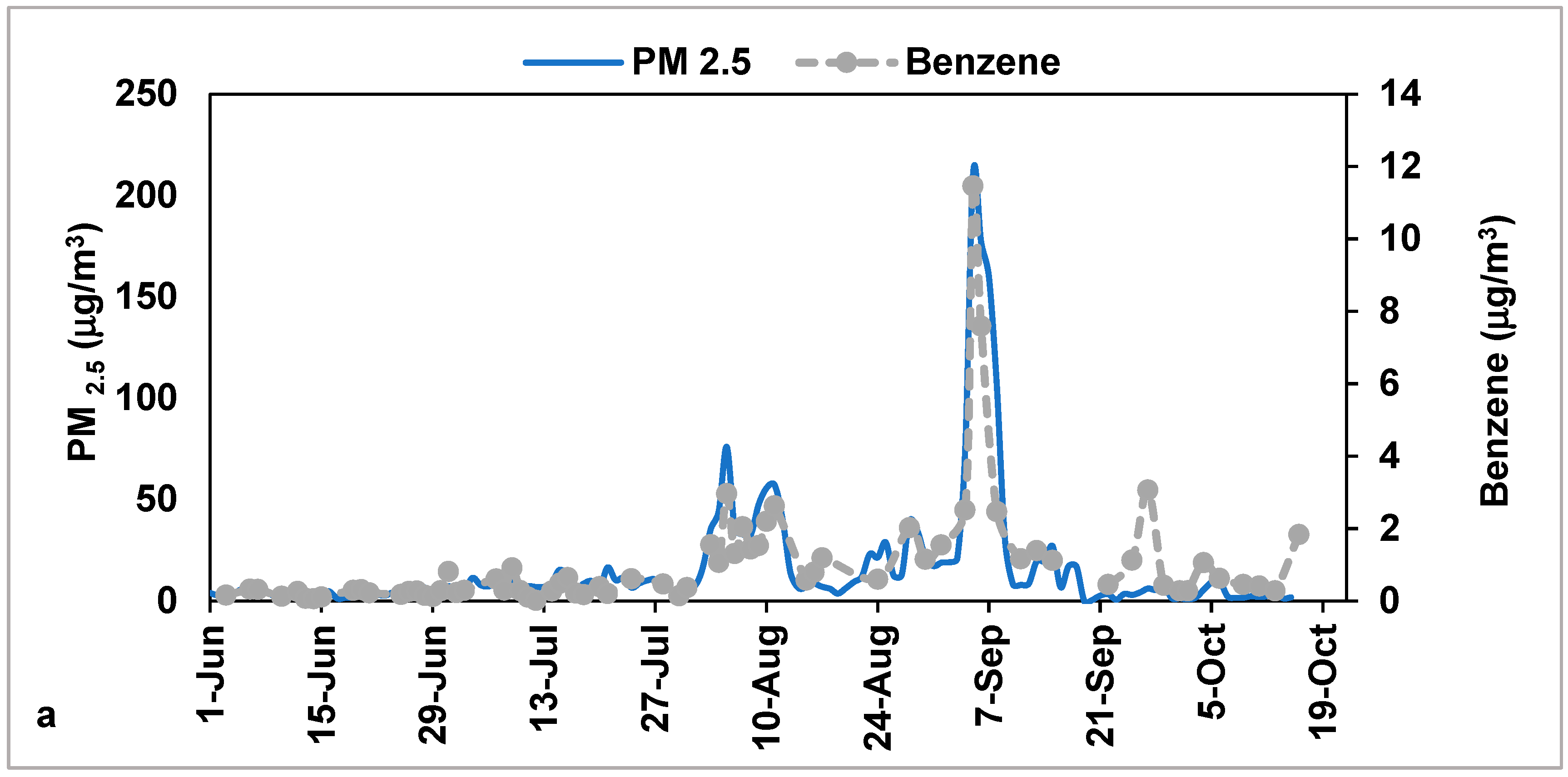
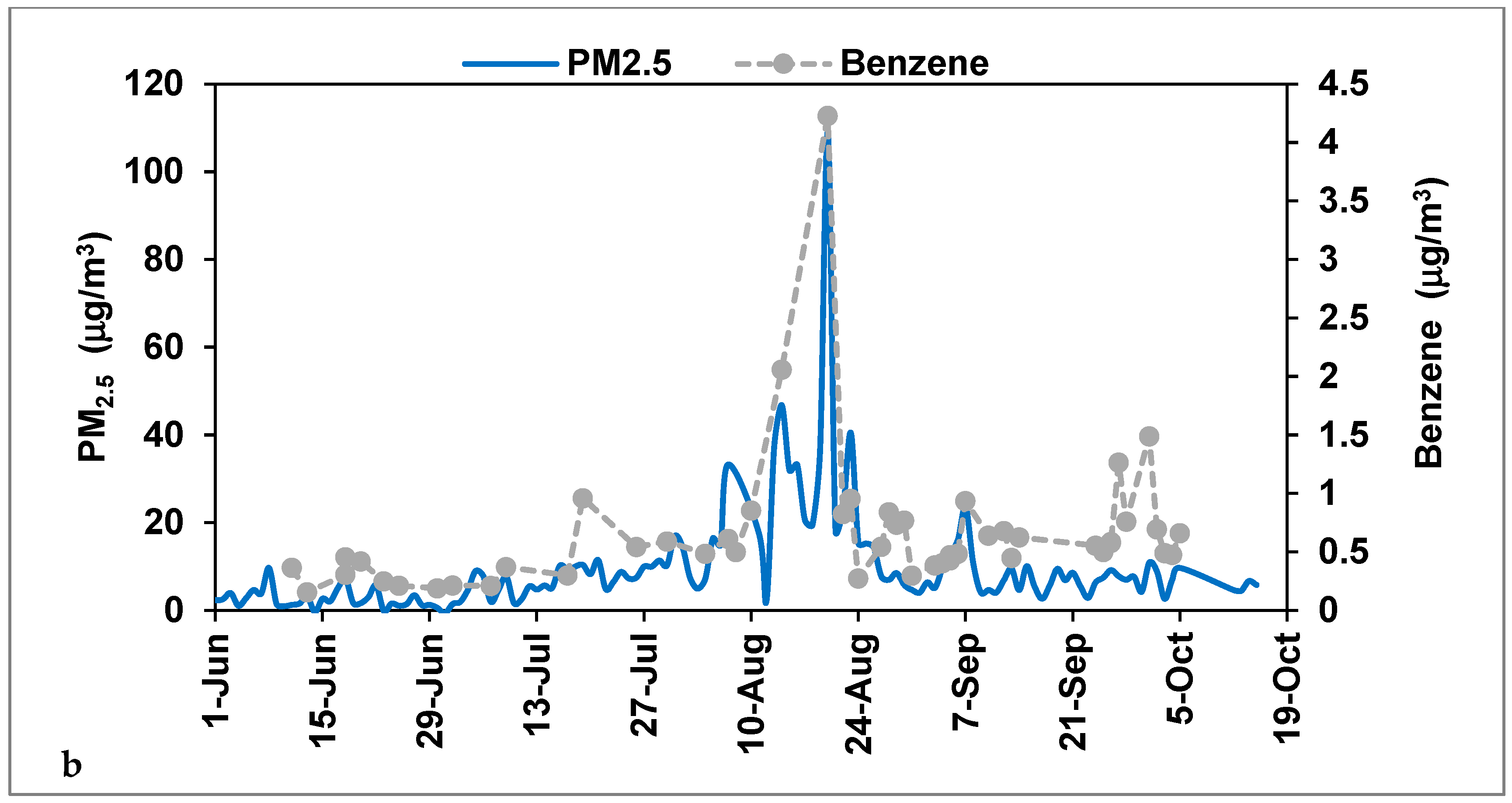


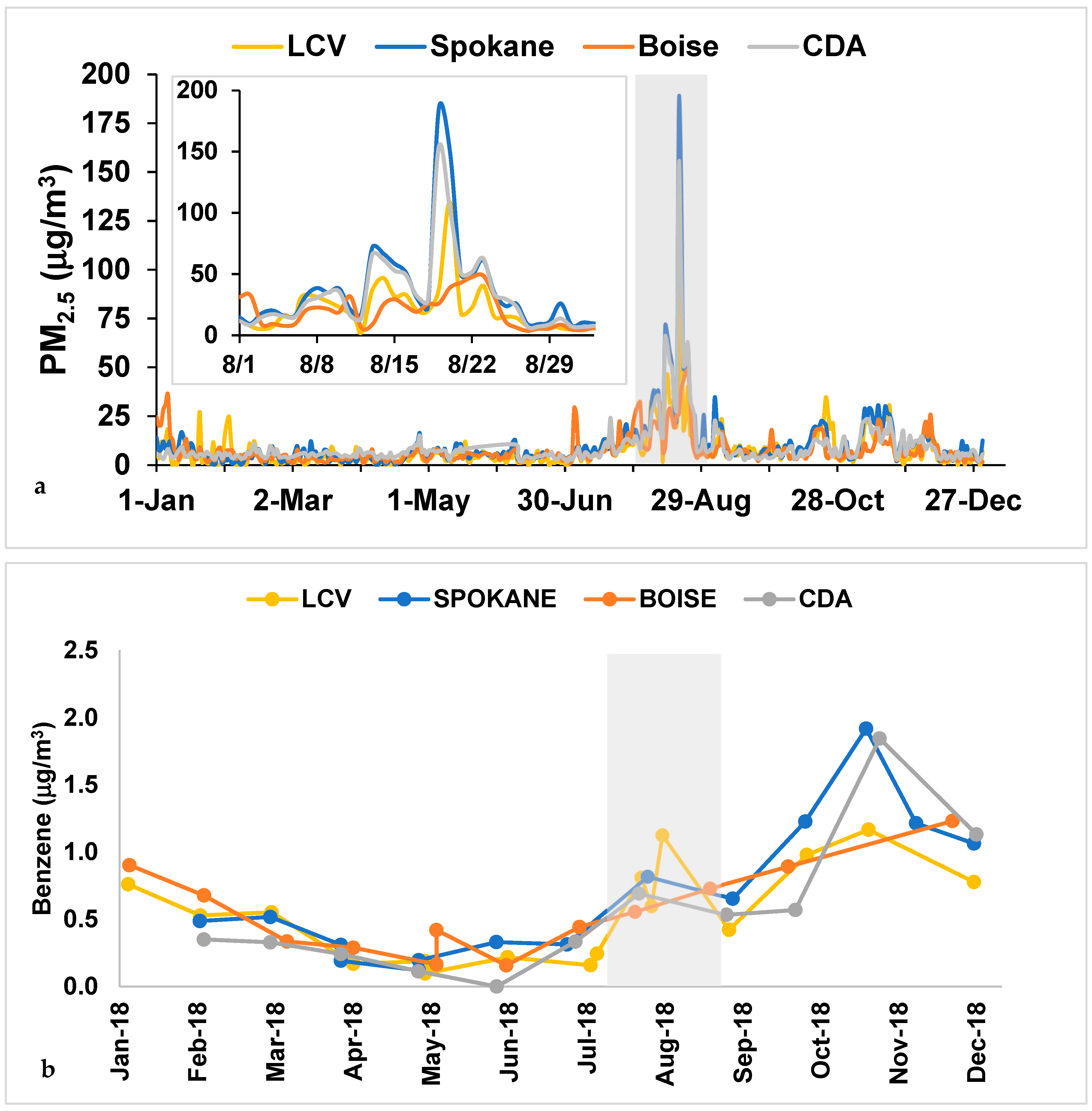
| 2017 | Background Samples (n = 125) | Biomass Burning Samples (n = 44) | ||||||
| Compound | % ND | Min–Max | Mean ± S | UCL | % ND | Min–Max | Mean ± S | UCL |
| Benzene * | 5 | 0.02–3.42 | 0.45 ± 0.54 | 0.67 | 0 | 0.18–11.46 | 2.14 ± 2.30 | 2.89 |
| Benzene, propyl- * | 75 | 0.02–0.61 | 0.05 ± 0.10 | 0.09 | 39 | 0.02–0.56 | 0.10 ± 0.12 | 0.18 |
| Dichlorodifluoromethane * | 0 | 2.51–17.87 | 6.31 ± 2.91 | 6.75 | 0 | 5.49–12.90 | 8.71 ± 1.32 | 9.04 |
| Ethylbenzene * | 32 | 0.01–2.55 | 0.20 ± 0.38 | 0.34 | 5 | 0.01–1.78 | 0.42 ± 0.44 | 0.71 |
| m,p-Xylene * | 10 | 0.02–12.31 | 0.88 ± 1.71 | 1.55 | 2 | 0.02–6.25 | 1.50 ± 1.60 | 2.50 |
| Naphthalene * | 79 | 0.01–0.89 | 0.05 ± 0.12 | 0.08 | 59 | 0.01–0.89 | 0.12 ± 0.18 | 0.18 |
| p-cymene * | 61 | 0.01–1.24 | 0.14 ± 0.25 | 0.19 | 7 | 0.01–2.57 | 0.49 ± 0.49 | 0.65 |
| Phenol * | 63 | 0.02–4.58 | 0.26 ± 0.62 | 0.32 | 2 | 0.02–2.37 | 0.66 ± 0.43 | 0.79 |
| Trichloromonofluoromethane * | 1 | 0.01–4.73 | 0.97 ± 0.62 | 1.07 | 0 | 0.37–2.69 | 1.21 ± 0.56 | 1.35 |
| Benzene, 1,2,4 trimethyl | 85 | 0.06–4.16 | 0.22 ± 0.57 | 0.34 | 70 | 0.06–0.74 | 0.13 ± 0.14 | 0.17 |
| Dimethyl sulfide | 50 | 0.02–40.55 | 1.99 ± 5.80 | 3.97 | 41 | 0.02–54.99 | 3.28 ± 8.77 | 7.49 |
| Disulfide, dimethyl | 78 | 0.01–25.57 | 0.56 ± 3.12 | 1.80 | 68 | 0.01–5.64 | 0.27 ± 0.87 | 0.75 |
| Mesitylene | 67 | 0.02–1.15 | 0.08 ± 0.17 | 0.15 | 50 | 0.02–0.73 | 0.11 ± 0.15 | 0.16 |
| Methylene chloride | 6 | 0.02–2.32 | 0.17 ± 0.21 | 0.19 | 0 | 0.08–1.71 | 0.23 ± 0.24 | 0.29 |
| Tetrachloroethylene | 74 | 0.01–1.85 | 0.07 ± 0.23 | 0.16 | 45 | 0.01–0.62 | 0.10 ± 0.14 | 0.19 |
| Toluene | 1 | 0.01–41.95 | 1.99 ± 5.57 | 4.17 | 0 | 0.21–12.8 | 2.98 ± 2.92 | 3.75 |
| Trichloromethane | 29 | 0.01–1.55 | 0.14 ± 0.22 | 0.23 | 20 | 0.01–1.13 | 0.21 ± 0.23 | 0.29 |
| 2018 | Background Samples (n = 120) | Biomass Burning Samples (n = 48) | ||||||
| Compound | % ND | Min–Max | Mean ± S | UCL | % ND | Min–Max | Mean ± S | UCL |
| Benzene * | 0 | 0.09–1.26 | 0.44 ± 0.23 | 0.48 | 0 | 0.23–5.12 | 1.42 ± 1.53 | 2.38 |
| Ethylbenzene * | 42 | 0.01–1.14 | 0.09 ± 0.14 | 0.14 | 19 | 0.01–0.62 | 0.21 ± 0.20 | 0.27 |
| m,p-Xylene * | 22 | 0.02–5.09 | 0.35 ± 0.58 | 0.55 | 12 | 0.02–2.32 | 0.54 ± 0.47 | 0.69 |
| Naphthalene * | 78 | 0.01–0.36 | 0.03 ± 0.05 | 0.04 | 65 | 0.01–0.37 | 0.08 ± 0.12 | 0.11 |
| p-cymene * | 40 | 0.01–0.80 | 0.14 ± 0.18 | 0.21 | 21 | 0.01–2.16 | 0.38 ± 0.48 | 1.17 |
| Toluene * | 1 | 0.01–3.93 | 0.65 ± 0.59 | 0.75 | 0 | 0.15–4.49 | 1.51 ± 1.44 | 2.32 |
| Benzene, propyl- | 84 | 0.02–0.31 | 0.03 ± 0.04 | 0.05 | 65 | 0.02–0.14 | 0.04 ± 0.04 | 0.05 |
| Carbon Tetrachloride | 47 | 0.03–0.50 | 0.22 ± 0.18 | 0.25 | 79 | 0.03–0.46 | 0.10 ± 0.14 | 0.13 |
| Dichlorodifluoromethane | 0 | 3.83–5.97 | 4.70 ± 0.38 | 4.76 | 0 | 3.95–5.50 | 4.59 ± 0.40 | 4.69 |
| Dimethyl sulfide | 15 | 0.02–16.00 | 1.75 ± 3.30 | 3.07 | 12 | 0.02–13.88 | 2.45 ± 3.37 | 10.33 |
| Disulfide, dimethyl | 85 | 0.01–5.25 | 0.25 ± 0.91 | 0.10 | 75 | 0.01–3.34 | 0.16 ± 0.53 | 0.43 |
| Methylene chloride | 2 | 0.02–0.71 | 0.20 ± 0.08 | 0.21 | 0 | 0.10–0.25 | 0.18 ± 0.03 | 0.19 |
| Tetrachloroethylene | 72 | 0.01–0.47 | 0.05 ± 0.08 | 0.05 | 71 | 0.01–0.34 | 0.03 ± 0.06 | 0.02 |
| Trichloromethane | 8 | 0.01–3.33 | 0.25 ± 0.39 | 0.40 | 17 | 0.01–1.07 | 0.23 ± 0.23 | 0.48 |
| Trichloromonofluoromethane | 0 | 0.29–2.40 | 1.33 ± 0.40 | 1.39 | 0 | 0.52–2.11 | 1.37 ± 0.35 | 1.46 |
| PM2.5 BG | PM2.5 BB | |
|---|---|---|
| Benzene | 0.09 * | 0.69 * |
| Benzene, 1,2,4 trimethyl | 0.00 | 0.03 |
| Benzene, propyl- | 0.03 * | 0.25 * |
| Carbon Tetrachloride | 0.03 * | 0.03 |
| Dichlorodifluoromethane | 0.01 * | 0.02 |
| Dimethyl sulfide | 0.05 | 0.00 |
| Disulfide, dimethyl | 0.00 * | 0.04 * |
| Ethylbenzene | 0.02 * | 0.29 * |
| m,p-Xylene | 0.02 * | 0.09 * |
| Mesitylene | 0.02 * | 0.04 * |
| Methylene chloride | 0.01 | 0.00 |
| Naphthalene | 0.01 | 0.56 * |
| p-cymene | 0.11 * | 0.54 * |
| Phenol | 0.00 | 0.01 |
| Tetrachloroethylene | 0.02 * | 0.01 |
| Toluene | 0.02 * | 0.39 * |
| Trichloromethane | 0.13 * | 0.00 |
| Trichloromonofluoromethane | 0.01 * | 0.01 |
| Compound | CA BG | CA BB | EC BG Res | EC BB Res | EC BG Life | EC BB Life | IUR | RfC | Cancer Risk Res | Cancer Risk Life | HQ |
|---|---|---|---|---|---|---|---|---|---|---|---|
| Benzene | 0.7 | 2.941 | 0.23 | 0.09 | 0.64 | 0.24 | 7.80 × 10−6 | 30 | 2 × 10−6 | 7 × 10−6 | 2.9 × 10−2 |
| Trichloromethane | 0.23 | 0.52 | 0.07 | 0.02 | 0.21 | 0.04 | 2.30 × 10−5 | 98 | 2 × 10−6 | 6 × 10−6 | 2.6 × 10−3 |
| Methylene Chloride | 0.22 | 0.33 | 0.07 | 0.01 | 0.20 | 0.03 | 1.00 × 10−8 | 600 | 8 × 10−10 | 2 × 10−9 | 3.8 × 10−4 |
| Tetrachloroethylene | 0.05 | 0.18 | 0.02 | 0.01 | 0.04 | 0.01 | 2.60 × 10−7 | 40 | 6 × 10−9 | 2 × 10−8 | 1.5 × 10−3 |
| Benzene, 1,2,4 trimethyl | 0.33 | 0.15 | 0.11 | 0.00 | 0.30 | 0.01 | NA | 60 | 5.2 × 10−3 | ||
| Benzene, propyl | 0.07 | 0.23 | 0.02 | 0.01 | 0.06 | 0.02 | NA | 1000 | 7.9 × 10−5 | ||
| Ethylbenzene | 0.31 | 0.57 | 0.10 | 0.02 | 0.29 | 0.05 | NA | 1000 | 3.3 × 10−4 | ||
| Mesitylene | 0.11 | 0.11 | 0.04 | 0.00 | 0.10 | 0.01 | NA | 60 | 1.9 × 10−3 | ||
| Naphthalene | 0.07 | 0.19 | 0.02 | 0.01 | 0.06 | 0.02 | NA | 3 | 2.5 × 10−2 | ||
| Toluene | 3.34 | 4.58 | 1.09 | 0.14 | 3.06 | 0.38 | NA | 5000 | 6.9 × 10−4 | ||
| Xylene (m,p) | 1.46 | 2.61 | 0.47 | 0.08 | 1.34 | 0.21 | NA | 100 | 1.6 × 10−2 | ||
| Cumulative | 5 × 10−6 | 1.3 × 10−5 | 8.3 × 10−2 |
| Site | CA BG | CA BB | EC BG Resident | EC BB Resident | EC BG Lifetime | EC BB Lifetime | Cancer Risk Resident | Cancer Risk Lifetime | HQ |
|---|---|---|---|---|---|---|---|---|---|
| LCV | 0.69 | 1.15 | 0.23 | 0.04 | 0.61 | 0.09 | 2 × 10−6 | 5 × 10−6 | 0.02 |
| Boise | 0.78 | 0.56 | 0.25 | 0.02 | 0.68 | 0.05 | 2 × 10−6 | 6 × 10−6 | 0.02 |
| Coeur d’Alene | 0.91 | 0.69 | 0.30 | 0.02 | 0.80 | 0.06 | 2 × 10−6 | 7 × 10−6 | 0.03 |
| Spokane | 0.97 | 0.82 | 0.32 | 0.03 | 0.85 | 0.07 | 3 × 10−6 | 7 × 10−6 | 0.03 |
| Biomass-Burning Study | Study Area | Main Pollutant(s) | Benzene Levels Measured | Cancer Health Risk (Per Million) |
|---|---|---|---|---|
| Current study | Northwest U.S., LCV (ground level) | BTEX | 0.02–11 µg/m3 (0.06–3.6 ppb) | 2–13 |
| Dickinson et al., 2022 [45] | Northwest U.S. (ground level, near fires) | BTEX | 0.06–80 µg/m3 0.02–25 ppb | 1–19 |
| O’Dell et al., 2020 [13] | Western U.S. (airborne) | Benzene, Acrolein, Formaldehyde | 0.1–10 µg/m3 0.03–3 ppb) | 2–10 |
| Navarro et al., 2021 [47] | Western U.S. (ground-level estimates) | Benzene, Acrolein, Formaldehyde | 4.5–19 µg/m3 1.4–6 ppb | NA |
| Wang et al., 2024 [48] | Northern California, U.S. (ground level) | BTEX | 1 ± 0.2 µg/m3 0.3 ± 0.06 ppb | NA |
| Jin et al., 2023 [16] | Western U.S. (airborne, ground level) | BTEX, Formaldehyde, Acetaldehyde | 0.03–0.96 µg/m3 0.01–0.3 ppb | NA |
Disclaimer/Publisher’s Note: The statements, opinions and data contained in all publications are solely those of the individual author(s) and contributor(s) and not of MDPI and/or the editor(s). MDPI and/or the editor(s) disclaim responsibility for any injury to people or property resulting from any ideas, methods, instructions or products referred to in the content. |
© 2024 by the authors. Licensee MDPI, Basel, Switzerland. This article is an open access article distributed under the terms and conditions of the Creative Commons Attribution (CC BY) license (https://creativecommons.org/licenses/by/4.0/).
Share and Cite
Ketcherside, D.T.; Miller, D.D.; Kenerson, D.R.; Scott, P.S.; Andrew, J.P.; Bakker, M.A.Y.; Bundy, B.A.; Grimm, B.K.; Li, J.; Nuñez, L.A.; et al. Effects of Wildfire Smoke on Volatile Organic Compound (VOC) and PM2.5 Composition in a United States Intermountain Western Valley and Estimation of Human Health Risk. Atmosphere 2024, 15, 1172. https://doi.org/10.3390/atmos15101172
Ketcherside DT, Miller DD, Kenerson DR, Scott PS, Andrew JP, Bakker MAY, Bundy BA, Grimm BK, Li J, Nuñez LA, et al. Effects of Wildfire Smoke on Volatile Organic Compound (VOC) and PM2.5 Composition in a United States Intermountain Western Valley and Estimation of Human Health Risk. Atmosphere. 2024; 15(10):1172. https://doi.org/10.3390/atmos15101172
Chicago/Turabian StyleKetcherside, Damien T., Dylan D. Miller, Dalynn R. Kenerson, Phillip S. Scott, John P. Andrew, Melanie A. Y. Bakker, Brandi A. Bundy, Brian K. Grimm, Jiahong Li, Laurel A. Nuñez, and et al. 2024. "Effects of Wildfire Smoke on Volatile Organic Compound (VOC) and PM2.5 Composition in a United States Intermountain Western Valley and Estimation of Human Health Risk" Atmosphere 15, no. 10: 1172. https://doi.org/10.3390/atmos15101172
APA StyleKetcherside, D. T., Miller, D. D., Kenerson, D. R., Scott, P. S., Andrew, J. P., Bakker, M. A. Y., Bundy, B. A., Grimm, B. K., Li, J., Nuñez, L. A., Pittman, D. L., Uhlorn, R. P., & Johnston, N. A. C. (2024). Effects of Wildfire Smoke on Volatile Organic Compound (VOC) and PM2.5 Composition in a United States Intermountain Western Valley and Estimation of Human Health Risk. Atmosphere, 15(10), 1172. https://doi.org/10.3390/atmos15101172









